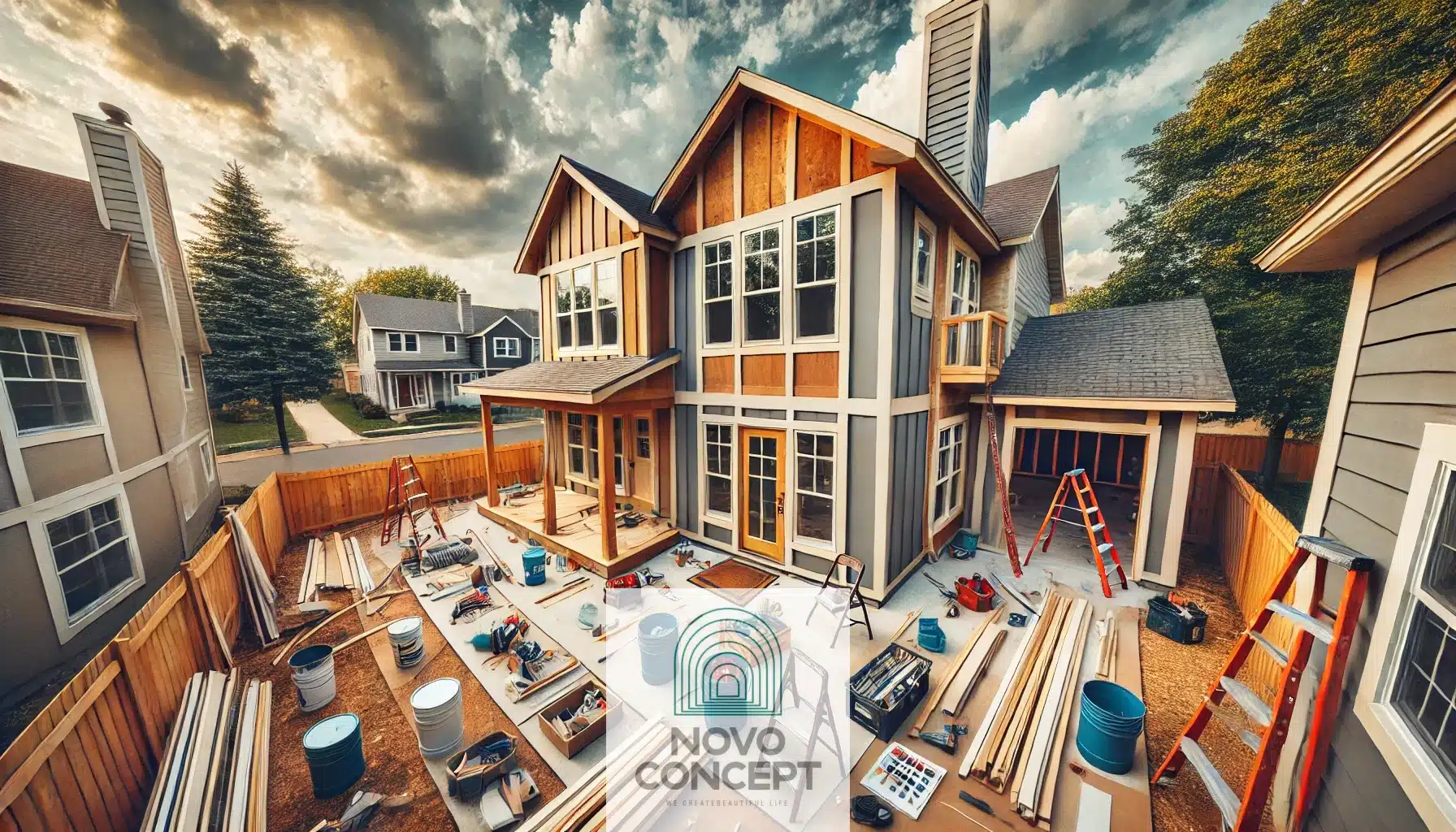Adding more space to your home can be an exciting yet challenging endeavor. Whether you need an extra bedroom, a larger kitchen, or a home office, building a home addition offers the opportunity to enhance your living space while increasing your property’s value. One approach gaining popularity among homeowners is shell construction. This guide from Novo Concept will walk you through the concept of shell construction, its advantages, and how to make the most of this cost-effective building strategy.
What Is Shell Construction?
Shell construction refers to the process where a contractor builds the structural framework, or “shell,” of a home addition. This typically includes the foundation, framing, roofing, exterior walls, and sometimes basic insulation. Once the shell is complete, homeowners can take charge of finishing the interior, either by themselves or with the help of subcontractors.
This method divides the responsibilities between the contractor and the homeowner, offering flexibility and potential cost savings. However, it also requires a clear understanding of construction tasks and proper planning to ensure the project is completed successfully.
Why Homeowners Choose Shell Construction
Shell construction can be an attractive option for various reasons. Here are some common motivations:
1. Cost Savings
By opting for shell construction, homeowners can save on labor and material costs associated with interior finishing. This is especially beneficial for those with a tight budget or those looking to invest their savings in high-quality finishes rather than upfront construction work.
2. Flexibility
With the structural work complete, homeowners have the freedom to personalize the interior design. From selecting flooring materials to choosing paint colors, shell construction allows for a customized approach that reflects individual tastes and needs.
3. DIY Enthusiasm
For those who enjoy hands-on projects, shell construction provides an opportunity to get involved in the building process. Homeowners with construction skills or experience can handle tasks such as painting, installing flooring, or even assembling cabinetry.
4. Access to Skilled Friends or Family
If you have friends or family members skilled in trades like plumbing, electrical work, or carpentry, shell construction allows you to tap into their expertise. This can reduce costs and ensure quality work.
What’s Included in a Shell Construction Project?
The scope of work covered by the contractor varies depending on the agreement. Here’s what is typically included and what’s left for the homeowner to complete:
Tasks Handled by the Contractor
- Foundation and Framing Contractors will lay the foundation and build the structural framework, including walls, floors, and roof systems.
- Exterior Work This includes installing siding, windows, and doors to ensure the addition is weatherproof and secure.
- Basic Insulation and Drywall Some contractors include insulation and drywall installation as part of the shell to provide a basic level of energy efficiency and comfort.
- Rough Mechanical Systems Essential systems like plumbing, electrical wiring, and HVAC ducts are often roughed in, allowing for easier installation of fixtures later.
Tasks Handled by the Homeowner
- Interior Finishes This includes painting walls, installing flooring, and selecting trim and baseboards.
- Fixture Installation Homeowners can add light fixtures, faucets, sinks, and cabinetry to complete the interior.
- Final Touches Decorating the space and arranging furniture are the final steps to make the addition feel like home.
Key Considerations for Successful Shell Construction
While shell construction offers numerous benefits, it also requires careful planning and execution. Here are some factors to consider:
1. Skill Level and Time Commitment
Before committing to shell construction, assess your skills and availability. Tasks like painting and flooring may be manageable for DIY enthusiasts, but electrical and plumbing work often require professional expertise to meet code requirements.
2. Budget Planning
Determine how much you can allocate to the project, including both the contractor’s work and the finishing tasks. Be sure to budget for unexpected expenses, such as additional materials or tools.
3. Clear Communication with the Contractor
Establish a detailed agreement that outlines the scope of work for both parties. This ensures everyone understands their responsibilities and reduces the risk of misunderstandings.
4. Permits and Inspections
Clarify who will obtain permits and arrange inspections for different phases of the project. Contractors typically handle permits for the shell, but homeowners may need to secure permits for tasks they complete themselves.
5. Financing Considerations
If you’re financing the project, check with your lender about restrictions on homeowner-completed work. Some lenders may require professional completion of certain tasks to protect their investment.
Pros and Cons
To help you decide if shell construction is right for you, here’s a quick comparison of its advantages and potential drawbacks:
Pros
- Cost-Effective: Reduces labor costs and allows for more control over material expenses.
- Customizable: Offers the freedom to choose interior finishes and layouts.
- Hands-On Involvement: Perfect for homeowners who enjoy DIY projects.
Cons
- Time-Consuming: Completing the interior can take significant time and effort.
- Requires Skills: Some tasks may be beyond the capabilities of inexperienced homeowners.
- Permit Challenges: Navigating permits and inspections can be daunting without prior experience.
Steps to Plan Your Shell Construction Project
- Define Your Goals Determine why you’re building the addition and what features you want to include.
- Set a Budget Account for the contractor’s fees and the cost of finishing materials and labor.
- Hire a Reputable Contractor Look for contractors with experience in shell construction and positive customer reviews.
- Create a Timeline Establish a realistic schedule for the contractor’s work and your finishing tasks.
- Gather Necessary Permits Work with your contractor to ensure all required permits are obtained.
- Plan for Inspections Schedule inspections at key stages of the project to ensure compliance with local codes.
- Execute Finishing Work Focus on completing one task at a time to avoid feeling overwhelmed.
Conclusion
Shell construction offers a flexible, cost-effective way to build a home addition tailored to your needs. By understanding the process, planning carefully, and collaborating effectively with your contractor, you can transform your vision into reality. Whether you’re a DIY enthusiast or simply looking to save on construction costs, shell construction can help you create the space you’ve always wanted.






